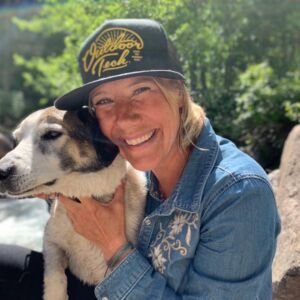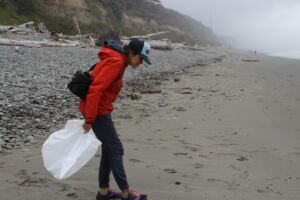En el Campo, Exploring Public Lands:
A Q&A with Lauren Berutich of Great Old Broads for Wilderness
Editor’s Note: Lauren is the Associate Director at Broads and an active member of the People, Public Lands and Climate Collaborative (Collaborative).
1. What is your organization doing to advance climate action and public lands victories through reconciliation, the infrastructure package or other efforts?
Great Old Broads for Wilderness (Broads) passionately believes that public lands must be a part of the solution to climate change and not a contributing factor to the climate crisis. Currently, all U.S. public lands combined, if considered a country, would rank fifth in the world as carbon-emitters. And, we are emitting 4.5 times more carbon than we are able to sequester — a great threat to our increasingly warming planet.
Climate scientists continue to warn that the Earth must not rise above 1.4 degrees Celsius to avoid irreversible, catastrophic damage.
Broads’ actions are put to the test! We have been tirelessly working to oppose new oil and gas lease sales on public lands, including supporting litigation in favor of President Biden’s leasing pause.
 We have teamed up with our partners in the Collaborative to speak with the Department of the Interior and the Bureau of Land Management’s leadership to support and encourage a revisioning of public lands management. We want to see processes in place to ensure old growth forests are protected and kept intact while also making sure rivers, streams, wetlands, and the ocean is protected as carbon sinks and for critical habitat, and that 30 percent of our lands and waters are protected through permanent designations to continue to build resilience against the climate crisis.
We have teamed up with our partners in the Collaborative to speak with the Department of the Interior and the Bureau of Land Management’s leadership to support and encourage a revisioning of public lands management. We want to see processes in place to ensure old growth forests are protected and kept intact while also making sure rivers, streams, wetlands, and the ocean is protected as carbon sinks and for critical habitat, and that 30 percent of our lands and waters are protected through permanent designations to continue to build resilience against the climate crisis.
We were thrilled to see $350 million grant program passed for wildlife corridor overpass and underpass development in the infrastructure bill and will continue to collectively urge for further policies and allocation of funds for wildlife conservation through bills such as Wildlife Corridors Conservation Act, SAVE Right Whales Act, and Recover America’s Wildlife Act. Research shows that intact habitats contribute to healthy lands and climate resilience.
In November, Broads held 53 meetings with legislators during our Virtual D.C. Lobby Days. We were thrilled to see such enthusiastic participation from our grassroots members across the country and to make such a big splash federally. We lobbied for the bills mentioned above, but also for the Protect America’s Wilderness and Public Lands Act (PAW +) legislation that would protect over 1.9 million acres of lands and waters across the U.S.
What an incredible opportunity, in one package, to protect lands critical to fight climate change.
2. What is the connection between public lands (or the environment for that matter) and the work your organization does?
Broads is a national, women-led, grassroots nonprofit organization aimed to engage and inspire activism to protect public lands and wilderness. We firmly believe that preserving this nation’s last wild places has significant impacts on climate health. Not only that, but it is the right thing to do- the only thing to do, to live on this planet responsibly and in harmony with the natural living world around us. We are inevitably accountable to future generations and can’t turn a blind eye to our human impact and our daily decision making.
As a small organization, Broads consistently punches above our weight because we engage grassroots volunteers, and together we roll up our sleeves, work hard, and play hard. We know we can do challenging work and approach it with humor, fun, and a nurturing touch. We love this work, and it shows! We’ve grown significantly in the past decade or so. Currently, we have 10 staff and 40 chapters (Broadbands) volunteering across 15 states. Our Broadbands are the eyes and ears on the ground locally and regionally. They are the backbone of our organization. Every single one of our members speaks about public lands with heart and passion and works by our side taking actions to protect them every single day.
3. How does your role or do your contributions and those of your team in the Collaborative advance your policy and advocacy goals?
I love this group! We received a small grant via The Wilderness Society to further advance our climate education and advocacy work. Through that, we had the honor of attending an in person, three-day gathering of brilliant leaders in the field of climate advocacy in recent years. There, what would become the Collaborative really took shape and we developed climate justice and public lands protection commitments that we, together, could work on together and advance internally with our own organizations. I believe this is a very symbiotic relationship. We share legislation, current issues, and creative ideas to the group to partner on and the group shares communications, capacity in leadership, and brilliant ideas back to our organization.
4. Personally speaking, how do you find and connect with the outdoors?

I grew up in Jersey and as a kid I remember picking up rocks in creeks or lying flat on my back to watch vultures circling above me. It was more challenging to find really remote or wild places, but I did — there’s wild everywhere, even in a small backyard or an abandoned parking lot. I was called to the west 20 years ago and found a new kind of wild inside of me. I love to trail run and feel my feet rooted in the dirt. I love the quiet of being out and moving my body. I take as much time as I can to backpack and get deep into a wilderness. Then there are river trips and the bliss of being on the water and held by canyons and landscapes passing by.
I don’t know a life where I didn’t deeply connect with nature — I can feel it in my bones. It is where I am my very most connected, peaceful and present self. It is where I feel solace and the deepest sense of gratitude.
5.How can public lands help foster a more inclusive understanding of community and the world?
Public lands are for everyone. It is essential that we acknowledge where and how these lands are managed, and why that makes it challenging for truly everyone to enjoy. There is blatant inequality in how accessible public lands are, how they are managed, and how communities are treated while using them.
Equity and justice work is essential in every aspect of our conservation movement to ensure inclusivity in public lands use and management. Broads have been working diligently to uncover our own
biases in our work and to incorporate equity and justice principles into every aspect of our programming, outreach, education, operations, and advocacy practices.
6.What are the top three actions you’d like to see Congress or the Biden Administration can take to preserve, protect and restore public lands?
- Keep it in the Ground! We absolutely must move quickly to support the just transition movement away from fossil fuels and to a renewable energy future. We have the opportunity to take care of our industry workers through training and support of a green economic livelihood that not only takes care of their health and wellbeing, but the community and the planet’s.
- Continue to do everything possible to fund and pass policy into law that protects our nation’s wild public lands and waters.
- Make climate change actions the number one priority in decisionmaking and continue to stand strong with commitments to reduce carbon emissions by 20 percent, while permanently protecting areas like the Boundary Waters, Grand Canyon, Bears Ears National Monument, and the Arctic National Wildlife Refuge from threats of mining and fossil fuel development.
7. How can the work the Collaborative is leading on be a differentiating role or driving vehicle in advocating for public lands?
We are a powerful team of diverse voices and organizations. The more we work together to exchange information and resources, the more powerful our collective voices will be as changemakers. I want to work with the Collaborative to continue to narrow our focus on a few key policies we can prioritize both in our organizational work and as a team — to press those issues on a federal level through strategic planning and collaborative efforts. The time is now. I feel confident as a Collaborative, we’ll continue making waves in 2022.